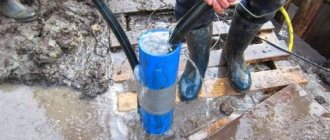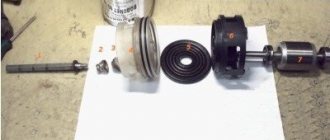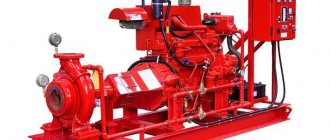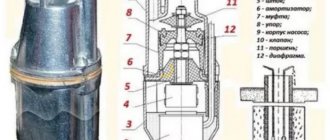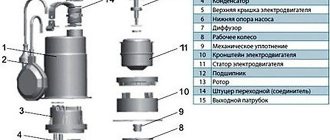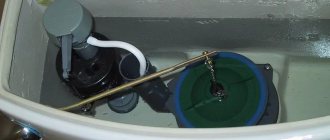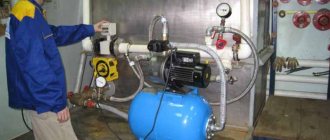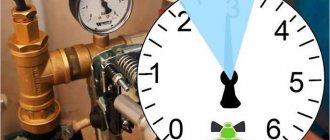You should repair the water pump yourself if you have the appropriate experience. Pumping equipment can make the life of the owner easier by solving many problems that may arise during the construction or arrangement of the main building on the private territory. This device will ensure uninterrupted water supply to the house, increase the pressure in the existing pipeline system, and also do an excellent job of discharging waste water. But any technology can fail, no matter how high-quality it is. Malfunctions of household pumps, pumps or water stations occur if the equipment does not receive proper attention, care and prevention. In this case, it is necessary to repair the electric pumps or replace them.
Main types of home appliances
The choice of a car pump always depends on its purpose. Namely: for what needs is it needed? The device can be used in everyday life for completely different purposes. For example, for a heating system, as a rule, a circulator is suitable; even a small, low-power device can cope with watering. There are also universal units that can cope with different tasks.
Before repairing a water pump, it is worth studying the advice of professionals.
Each device has different parameters. Therefore, you should not purchase the first unit you come across; first, you should study its instructions and identify all its positive and negative aspects.
Today on the market you can find a huge selection of household water pumps. They all have their own individual design, advantages and purpose.
Types of water pumps:
- Submersible. Such equipment only works when it is completely or partially immersed in liquid. Deep well immersion devices are usually made of high-quality stainless steel or polymer.
- Drainage structures. Their purpose is to pump water from a number of different places (swimming pools, basements).
- Superficial. Garden devices of this type are very popular, suitable for pumping drinking water.
- The most common pumps are centrifugal ones. They are installed on heating systems.
- Vibrating. Serve for pumping liquid.
All these pumps are of an electric type, booster in nature, and are high-pressure apparatus. There are also manual devices that operate from the effort of one person.
Why does a submersible pump break?
To determine the cause of a potential malfunction, you need to know how the submerged sediment is tripled.
Types of equipment
There are two types of units that can operate in water, either completely or partially.
- Vibrating units in which there are no rotating elements. These devices work for a limited time, they have a low price, and are quite economical.
- Centrifugal devices. In this case, the electric motor is responsible for the operation of the rotating element - the impeller, or several. These pumps are capable of operating in any season, at great depths. These devices are protected from damage.
There are no ideal devices, but there are statistics - an argument with which you cannot argue. According to it, in 95% of all cases, the fault for breakdown lies with those consumers who incorrectly operated the submersible equipment. The remaining 15% is distributed between manufacturing defects and other reasons, which need to be discussed in more detail.
Symptoms of malfunction
There are several types of failures in the operation of deep-well equipment, but they do not appear immediately. As a rule, the owners first notice that the water pressure decreases without obvious reasons and that it flows unevenly to users. At the same time, the noise level increases, vibration occurs, and for some reason the energy consumption increases.
If owners have noted at least one of the listed symptoms, then they need to begin to act immediately. Ignoring the emerging problem will cause an imminent accident. Therefore, it is better to bring the equipment to the surface as quickly as possible and then carry out a thorough inspection.
Reasons for failure of submersible devices
The first logical option is the assumption that the liquid and the fine suspension in it are to blame for the malfunction of the submersible pump.
- Regardless of the type of well and the design features of the pump, abrasive particles and natural inclusions contained in the water have a negative impact on the working parts of the submersible device. They clog the filter and gradually accumulate, significantly reducing the efficiency of the equipment.
- Another development of events is possible: this is a violation of the tightness of the device body, moisture getting inside. The consequence of such a malfunction is malfunction of the electronics and electric motor, which also leads to disruption of the normal functioning of the submersible pump. In this case, the equipment is at risk of a short circuit.
- Reaching a critical value of the dynamic level. In such a situation, the pump begins to “grab” air, so it has to work in unfavorable conditions, which are called “dry running” mode. Due to the lack of fluid, the friction between the working elements increases, the components overheat, and the resistance and energy consumption increase.
These are the main causes of submersible pump failure, but they are far from the only ones. Severe and persistent power surges, which are always a threat to unprotected equipment, may be to blame. This category also includes poor contacts in signal or power supply networks, natural wear of structural elements, and jamming of the impeller by large abrasive particles.
Neglect of preventive maintenance, use of a very high-power pump, incorrect fixation of the safety rope on the head, improper lifting of the device (by the float, power cable) can also cause problems. Excessively high temperatures (over 40°) and sensor malfunctions complete the list.
Possible causes of malfunction
Even if the owner purchased a branded, high-quality pump, the possibility of its failure cannot be ruled out. Since the work of all water structures is usually associated with water, such a device is constantly prone to negative influences.
A high pressure water pump is a device that costs a lot of money. Therefore, it is easier to repair it than to spend a considerable amount on new equipment.
Of course, you can learn how to repair a unit, but it is better to operate it correctly from the very beginning, carry out regular inspections, and do preventive maintenance.
Often the cause of pump failure is worn parts
Possible reasons leading to device failure:
- Dry operation, water hammer;
- Power surges;
- Pumping very contaminated liquid;
- Operation in winter;
- Poor quality cable connection;
- The submarine cable is not secured correctly;
- The working fluid exceeds its level by 40%;
- No oil;
- Lack of grounding leading to corrosion;
- The pressure switch has failed;
- The magnet is broken;
- The hydraulic tank is not working properly.
All of the above factors, to one degree or another, cause the device to malfunction. In some cases, you can make repairs yourself, but there are also breakdowns that can only be corrected with the help of specialists.
Typical problems with submersible devices
Before you start taking action, you need to learn about the features of models from different manufacturers. As a rule, all devices have their own weak points, which inevitably appear during operation and repair, so they can already be correlated with the manufacturer.
Aquarius
These pumps are known to overheat. This situation is especially often observed when operating equipment in not very deep wells. If this type of malfunction is detected in a budget device model, then it is much easier for the owners to buy a new device than to try to revive the old one. In this case, the repair will “take away” about 50% of the cost of the new unit.
Water cannon
This equipment is reliable, so usually there are no problems during operation. An exception may be devices that are not used correctly. Frequent causes of submersible pump failure include contamination with sand or silt. In this case, the pump part of the device must be replaced.
Gilex
The weak point of these submersible pumps is the electric motor, from which liquid leaks. The best option is to refill with a similar composition, but such an operation is only possible at a service center. There are alternatives - glycerin or transformer oil. However, these substances will invariably lead to equipment failure.
Baby
These devices are among the most popular devices. The most common problem with them is the loud noise that occurs when turned on without pumping out the liquid. The reason is a rupture in the central axis where the membranes with the anchor are located. In this case, the element requires replacement, but finding this node is not easy. Another option is to have it made to order.
Brook
The “Achilles heel” of these models is overheating, and this problem occurs quite often. The device fully complies with European quality standards. Therefore, purely theoretically, the equipment should work non-stop for at least 7 hours. In fact, the device requires breaks in operation every 2-3 hours.
Grundfos
Most of these designs have built-in valves, as well as a special type of thermal insulation for the motor. Sometimes the engine needs to be removed to replace failed seals. In this case, the work must be done by a specialist.
Marquis
It has been noticed more than once that this equipment sometimes turns on only after an impact (on a pipe, on a unit). In this case, the cause of temporary failure is souring of the impeller. To eliminate this problem, the pump is disassembled and the element is cleaned.
How to repair a device
You can repair the pump yourself by purchasing a repair kit corresponding to the model on the market and replacing non-functioning elements. Before repairing, it is necessary to assess the general condition of the device, identify the cause of the malfunction, and also choose an effective method for eliminating the breakdown.
First of all, you need to make sure that the device has stopped working not due to a power surge or its complete absence. For this, a special device is used that determines the normal voltage level of 200-240 V.
Before proceeding to the main malfunction, you need to check the integrity of the main components: piston, valves, magnetic coil. The air supply must also be uniform.
Frequent breakdowns:
- The pump does not pump water, but it makes noise. This breakdown occurs due to the loosening of the nuts that secure the shock absorber. They need to be tightened. The check valve fails, the stem breaks - this is also the reason. In this case, the valve and rod are replaced with new ones.
- The device is prone to overheating and vibrates strongly. The cause of these breakdowns is the operation of the device outside of water, which leads to the magnet coming off and vibration of the pump. Here you need to return the magnet to its place using glue.
- Low pressure. This happens when the gaps in the vibrator are small, causing the pumping of water to slow down. You should return additional washers to the vibrator, then the problem will be eliminated.
- When starting the unit, the plug is knocked out. It is necessary to check the cable and winding. If the winding is burned out, it is better to seek help from the server center, where they will rewind it.
It is better to correct these malfunctions in a timely manner to prevent complete combustion of the device in the future.
How to disassemble a unit to diagnose a breakdown
If the pump breaks down and requires replacement of parts located inside its housing, the unit will need to be disassembled. A submersible pump consists of a motor compartment and a compartment with one or more impellers, the purpose of which is to capture water . Below is a diagram of the structure of that part of the centrifugal pump where the impellers are installed.
As can be seen from the figure, the impellers are installed on the shaft of the unit. The more there are, the higher the pressure created by the pump. A rotary engine is located in the second compartment of the hydraulic machine. It is in a sealed case, and to open it, you need to know some nuances.
So, to move from theory to practice and disassemble the pump, follow these steps (depending on the manufacturer, the design of the unit may differ).
- Unscrew the 2 screws holding the device grid.
- Remove the screen and rotate the motor shaft by hand. If it does not spin, then the problem may be either in the engine compartment or in the pumping part of the device.
- First you need to disassemble the pumping part of the device. Unscrew the 4 screws holding the power cable channel and disconnect it from the device body.
- Next, you should unscrew the 4 nuts holding the pump flange.
- After unscrewing the fasteners, separate the pumping part of the device from the engine. At this stage, it is possible to determine in which section the jamming occurred. If the pump compartment shaft does not rotate, then it is necessary to disassemble this unit.
- Unscrew all the fasteners holding the lower flange of the pump part of the unit.
- An adapter must be screwed into the fitting located at the top of the block, which will help protect the thread from damage.
- Secure the pump in a vice.
- Having selected a suitable tool, unscrew the lower flange.
- Now you can pull out the impeller assembly and inspect it to identify any problems.
- Next, you should check the support shaft for wear or play.
- To replace (if necessary) the impellers, you need to fix the shaft in a vice and unscrew the top nut.
- At the next stage, the blocks are removed, washed and, if necessary, replaced with new ones.
- Reassembling the pump part of the device is carried out in the reverse order.
- To disassemble the electric motor, it also needs to be secured in a vice.
- Next, you should remove the plastic flange protection by unscrewing the fasteners.
- Remove the retaining ring holding the cover in place using pliers.
- Remove the cover using a flat-blade screwdriver.
- Remove the rubber membrane from the housing.
- Remove the capacitor.
- At this stage, you can check the oil level, its quality, identify the cause of jamming, etc. The engine block is assembled in the reverse order.
Preventive measures
Preventive measures include the following: inspection of the device, cleaning, operation. The unit must be inspected once a quarter. This will be enough to identify any damage or malfunctions.
Equipment needs to be cleaned once every two or even three years. This depends entirely on the quality of the water itself and the conditions in which the water pump operates.
If you follow all operating conditions and carefully monitor the equipment, you can enjoy uninterrupted operation of the pump for a long time.
It is recommended to repair the pump when the pump is disconnected from the pipes
Periodic check of device operation:
- All connections must be checked for leaks, and if necessary, seals or gaskets must be replaced;
- Grounding is visually checked;
- The sound of the pump should be clear;
- The pressure is checked;
- No strong vibration in the engine;
- The housing must be clean and dry.
If there is any malfunction in the pump, it is necessary to immediately make a diagnosis and identify the cause. If it indicates a malfunction of the device, it must be repaired yourself or in a special workshop.
Not a single private arrangement of a plot or house is complete without a water pump. It is imperative to monitor its operation in order to prevent serious damage to the device.
Basic malfunctions in the operation of centrifugal pumps
The most likely causes of malfunctions in the operation of centrifugal pumps are: air entering the system and the pump, deterioration of suction conditions, wear and mechanical failure of moving parts of the pump, malfunction of the pump drive.
The entry of air into the system and the pump leads to failure of the pump - it either does not supply liquid at all, or its supply is less than nominal, the pump operates with noise. Air can enter the system and pump as a result of:
- poor-quality filling of the suction line and pump housing before starting; during rapid filling, an air bag may remain in the system or pump housing;
- air leakage into the pump during its operation. Air can enter the pump through leaks in the suction line (leaks at the connector points, through valve stem seals), through the pump seal, or through a partially exposed suction pipe mesh. The air entering during pump operation is partially carried away into the pressure line, and partially accumulates in the system fittings. With a slight air leak, the pump can operate normally at full flow, but when the flow is reduced and repeated starts, it can break down and stop the flow completely. To eliminate air leaks, it is necessary to eliminate leaks in the system and change the seal packing.
Deterioration of suction conditions leads to a decrease in flow, cavitation and failure of the pump. Absorption conditions worsen as a result of:
- clogging of the receiving grid (or filters) at the pump suction;
- foreign objects (rags, dirt) getting into the suction pipeline;
- operation of the pump with the foot valve not fully open;
- pumping liquid with a temperature above the specification or heavily contaminated liquid;
- reducing the static head at the suction below the specification for a given pump.
A deterioration in suction conditions is primarily signaled by an increase in the vacuum suction height of the pump. In this case, the pump should be stopped, the cause of the deterioration in suction conditions should be identified and eliminated.
Wear and mechanical breakdowns of the moving parts of the pump can lead to various malfunctions: increased vibration during pump operation, overheating of individual pump components, increased power consumption, and failure of the pump. The most common faults are:
- wear of the impeller blades (the pump operates with less flow or stops flowing) - worn out impellers must be replaced;
- clogging of the channels of the impellers or guide vanes (the pump also operates with less flow or stops flowing) - the pump must be disassembled and the channels cleaned;
- wear of the sealing rings (the pump operates with less flow and pressure as a result of liquid flowing across the gap) - worn rings must be replaced with new ones;
- wear of the unloading ring (in this case the pump rotor moves, the impellers move relative to the guide vane, the pump flow decreases) - it is necessary to replace the unloading rings;
- bending of the pump shaft due to unbalance of the rotor (in this case, the power consumption fluctuates, the pump vibrates)—the pump must be opened and the rotor checked;
- misalignment of the unloading disk or ring (the pump consumes more power during startup) - the misalignment must be eliminated;
- distortion of the pressure sleeve of the stuffing box or excessive tightening of the seal (the stuffing box heats up) - it is necessary to loosen the nuts, correct the distortion or loosen the tightness of the stuffing box;
- foreign inclusions in the stuffing box (the stuffing box heats up) - it is necessary to replace the stuffing box;
- the presence of water in the bath of the bearing assembly, contaminated or poor-quality oil (the bearing assembly heats up) - it is necessary to replace the oil;
- Excessive amount of oil in the bath of the bearing unit and grease in the ball bearing housing (the bearing unit heats up) - it is necessary to remove excess oil (grease);
- the gap between the unloading disk and the ring is reduced (the unloading disk heats up) - it is necessary to disassemble the pump and adjust the gap between the disk and the ring;
- the hydraulic unloading pipeline of the pump is clogged (the unloading disc heats up) - it is necessary to clean the pipeline;
- the fastenings of the pump on the frame, impellers on the pump shaft, pipelines and flanges of the pump are loose (strong vibration appears during pump operation) - the fasteners need to be tightened.
Malfunctions in the pump drive can prevent the pump from starting normally and lead to its failure. Considering that the most common drive is an electric drive, the following are typical faults of an electric drive:
- lack of power due to blown fuses or a malfunction of the circuit breaker (the electric motor does not start) - it is necessary to insert the fuses, correct and turn on the circuit breaker;
- a break in the starting rheostat or in the connecting wires between the rotor and the starting rheostat (the electric motor does not start) - it is necessary to find the break point and fix it;
- break of one phase of the stator winding of an asynchronous electric motor (the electric motor does not start) - it is necessary to determine the location of the break and correct it;
- turn-to-turn short circuit in the stator winding (the electric motor gets very hot during operation) - it is necessary to repair or replace the electric motor;
- the mains voltage is increased or decreased (the electric motor heats up) - with increased voltage, the engine must be turned off until the voltage decreases; if the voltage is reduced, you can work by partially reducing the pump flow by closing the control valve;
- violation of proper ventilation of the electric motor (the electric motor heats up) - it is necessary to clean the ventilation ducts and improve ventilation;
- mechanical damage (wear of bearings, protrusion of groove wedges, chipping of insulation and others causing abnormal noise in the engine, local overheating) - the malfunction must be eliminated.
Literature
Auxiliary mechanisms and ship systems. E. V. KORNILOV, P. V. BOYKO, E. I. GOLOFASTOV (2009)
Similar articles
- Marine Fist (Rotary) Pumps
- Rotary pumps - classification and application
- Marine piston pump parts
- Maintenance of marine piston pumps
- Adjusting the steam distribution of direct-acting pumps
- Designs of piston marine pumps
- Marine Pumps - Air Caps
- Piston pumps - operating principle and classification
- Main parameters of ship pumps
- Purpose and classification of ship pumps
4.5 Rating 4.50 (2 Votes)
Replacement cost
Not everyone takes on a water pump with their own hands if it must be replaced. They prefer to go to service centers or just some garage-type workshops, where prices are usually lower.
It is important to note that the cost of replacement directly depends on the car make, model and availability of the spare part itself. In some cases, replacement is carried out in literally 20 minutes. In other situations, craftsmen spend several hours. Moreover, most of the time is spent on getting to the pump and removing it.
All this has led to the fact that price tags vary greatly, depending on certain conditions and circumstances. In one case, you will pay about 1000 rubles. In another you will have to pay 5-6 thousand. And this does not take into account the cost of the newest pump for your car.
Design and principle of operation
The submersible pump Rucheek consists of the following parts:
- housing connected by four screws;
- electric drive;
- vibrator.
The device body is made in the form of a casing. In the upper section of the casing there is a glass for water flow through the holes and a pipe for water outlet. A special valve opens and closes the inlets.
The electric drive of the device consists of a core with two coils and a power cord.
The vibrator is composed of a shock absorber, a diaphragm, a stop, a coupling and a rod. At the top the rod is connected to the piston, at the bottom to the armature.
The vibrations of the armature and piston, which are created under the action of an elastic shock absorber, convert the network electricity into forward mechanical vibration. The piston, under the action of the rod, creates pressure in the glass with holes, the valve closes simultaneously and water is squeezed out into the outlet pipe.
Assembling the vibration pump Stream
Advantages of the upper water intake of the pump:
- The system self-cools during operation;
- the working body does not suck in sludge from the bottom.
Repair depending on the cause of the breakdown
If you experience a drought, the lack of water in the well will cause water to spray or spit out of the tap, creating a cloudy liquid. Repairs in this case do not need to be made, it may simply be temporary, or the pump may need to be installed deeper underground.
Insufficient pump size. The water pump must be sized to handle your home's water supply. Size is determined by the size of the plumbing system, such as the number of faucets and fixtures using water. If the device breaks down due to insufficient power, repair consists of purchasing new equipment, but of a different power.
Water pump overloaded with water. The pressure tank must also be rated for the water used at home. A pump that is called to pump only a few times a day will run significantly longer than one that cycles on and off several times a day. As a result of constant switching on/off of the device, electrical elements become faulty, the repair of which does not require large expenses.
Sediment in the water can cause significant wear on the unit by acting as an abrasive that slowly damages bearings and other components. Dirt, hard water minerals, small stones or other debris can reduce water flow or cause the unit to stop working completely, causing costly repairs.
It is difficult to know if a well pump is broken or if another part of the water system is not working properly. The most common plumbing repair is replacing the pressure tank or pressure switch, which will cost significantly less than the bill for replacing a water pump.
Types of water pumps, device features
Household pumps comprise three main groups, depending on the properties of the pumped liquids. They can be:
- Drainage, designed for pumping not very dirty water, which can also be used to supply clean water, which makes the units universal. Such devices can be used to pump out liquid from basements flooded with flood waters, or use them to pump water from a swimming pool. The motor of the device is well protected from water penetration into the body. A reliable oil seal protects the motor shaft from moisture. The impeller on which the blades are located, when the shaft rotates inside the chamber, creates excess pressure. The cavities located around the pump motor create a cooling circuit, which allows the pump to operate for a long time without overheating.
- Units that supply clean water are: surface, installed at some distance from the water source, and suction occurs through a rigid hose or intake pipeline. Water can be sucked in from a depth of up to 9 meters.
Surface pump
... submersible, partially or completely lowered into water and then fed upward. The depth of liquid intake can be up to 100 meters. The absence of rubbing parts and constant cooling with water protects such units from overheating.
Sewage devices are used to pump out domestic wastewater that contains solid particles. By design, these are drainage pumps, but with a special wheel that is capable of chopping large pieces of dirt into smaller ones. Without such units it is impossible to operate cesspools in country cottages.
Design and principle of operation of the switch
Float design: electric switch and steel ball placed in the internal cavity of a plastic housing. The cable length varies from 3 to 10 m. When the float switch reaches the upper mark, the switch contacts close, turning on the pump. As soon as the float descends to the lower mark, the steel ball acts on the switch lever, changing its location. The circuit opens and the system turns off.
Float switch connection diagram: a cable with three wires is connected to the switch. They vary in color, often being black, blue and brown. The common wire is marked in black. In the upper location of the float switch, the contacts of the common wire and the normally closed wire, marked in brown, are closed. At the minimum mark, the circuit is closed with the participation of a common wire and a normally open wire, indicated in blue. The insulation of wires not currently used in the circuit must be very reliable. It is understood that in an aquatic environment the cable must have sufficient moisture resistance, and the plastic case must be leak-tight. The cable outlet is equipped to relieve mechanical stress and is reliably sealed. The polymer resin filling the cavity of the cable glands prevents moisture from getting inside. And the last word in favor of the float switch is the price, which usually varies from 300 to 500 rubles. The combination of a reasonable price and reliability makes the purchase of a float switch the best option for providing protection against unwanted breakdowns of expensive equipment, such as household and industrial pumps.
How does a pumping station work?
Each part does its job.
When the pump is turned on, it begins to pump water into the accumulator until the water pressure reaches the limit set on the pressure switch. The pump turns off, after which water can be collected for household needs. This is possible until the water pressure is equal to the lower water pressure limit set on the pressure switch. The pressure switch is activated and turns on the pump, which raises the pressure level in the accumulator to the upper pressure level. And so every time, cycle after cycle.
In the case of long-term water withdrawal, when the water pressure cannot reach the upper pressure limit, the pump can operate for a long time. After the process of drawing water from the accumulator is completed, the pump can operate for some time until the water pressure rises to the desired level.
How to choose a water pump
Before purchasing a unit, it is necessary to clearly determine for what purposes the equipment will be used:
- Irrigation and watering of a personal plot.
- Home water supply.
- Carrying out drainage work.
- Use for a device in a heating system.
- Drainage of reservoirs.
After that:
The operating intensity of the unit is calculated, which depends on the volume of water required for the needs. It is not worth purchasing a model that has a low price. Be sure to carefully study the technical characteristics of the device and consumer reviews about it
The pump is designed for long-term operation, which indicates a long-term investment, and dismantling and then repairing or replacing the unit is a very expensive operation. When studying the technical characteristics of the device, special attention is paid to the following:
- is there protection for the pump from “dry running” and possible overloads;
- It is desirable that its parts are made of stainless steel, this will increase the service life of the product.
The requirements for the electrical network and what voltage is necessary for its use are taken into account.
Water pump device
The design principle of all water pumps for a home or cottage is one, common. During operation, the device creates a vacuum inside itself, after which the liquid is drawn into the vacuum chamber from the reservoir, then forcefully pushed out and directed through the pipe to its destination. According to the method of creating a vacuum, there are the following principles of operation of the units:
The electromagnet is the main element. When an alternating voltage is applied to its windings, the element attracts the armature to itself, and after changing the polarity, the armature returns to its original position. The photo shows the device of a water pump for a summer house.
Water pump device
- Within one second, the anchor makes one hundred oscillations.
- The piston connected to the armature vibrates the same number of times.
- Water is an elastic medium, so vibrations cause it to oscillate, and excess water is pushed through the valve into the discharge pipe.
How to carry out regular pump maintenance?
Pump design option
- Turn on the pump and in operating mode, check for any extraneous noise or excessive vibration.
- Check the coolant pressure supplied by the pump. It must correspond to the indicators stated in the technical data sheet.
- Make sure that the electric motor of the device does not become overheated.
- Check the presence of grease on the threaded flanges and, if necessary, restore it.
- Make sure there is a ground connection between the pump housing and the appropriate terminal.
- Inspect the pump from all sides and make sure there are no leaks. Typically, such vulnerable points are the interface between the pipeline and the housing of the pumping device. Check the tightening level of the bolts and the normal condition of the gaskets.
- Inspect the terminal box. All wires must be securely fixed. The presence of moisture in the unit is unacceptable.
Do-it-yourself surface installation and connection
Everything is much simpler here, because it should not be immersed in a body of water. The scheme boils down to the following steps:
- A pipe is installed on the suction element of the submersible unit, which will be lowered into the reservoir. The connection must be tight.
- After this, an automation system, such as a float, is installed.
- A check valve is fixed to the suction pipe. It will prevent water from flowing out when the engine is turned off.
- A filter is installed in front of the check valve. It will prevent large impurities from entering the motor.
- It is recommended that surface water devices be fixed and secured on a rigid platform. The unit should be protected from direct splashes.
- Once the installation process is completed, you can connect it to electricity.
As for the electrical connection diagram, it is indicated on the box or in the manufacturer’s passport.
Reasons and frequency of repairs
Pump repair, frequency of maintenance and durability depend on the principle of operation of the device and its materials. The type of pump that supplies/drains water in a home is a jet or submersible device. Pumps can be shallow or deep borehole devices with the ability to lift water from a height of 25 or 100 meters. Submersible pumps are installed deep inside the well and can push water hundreds of meters.
With proper care, a submersible pump can have a long service life of up to 15 years without repair. Aboveground jet pumps, which are more often used with shallow wells, have an average lifespan of 10 years.
Main characteristics indicating that the pump requires repair:
- No water flow from taps
- Poor weak pressure
- Constantly working device
Now that you know the signs of a breakdown, check out our detailed troubleshooting and repair guide.
